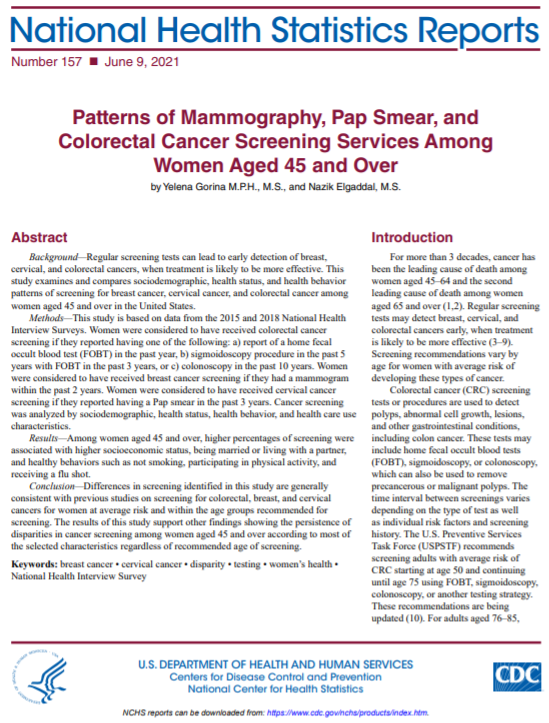Patterns of Mammography, Pap Smear, and Colorectal Cancer Screening Services Among Women Aged 45 and Over
Posted on by Questions for Yelena Gorina, Health Statistician and Lead Author of “Patterns of Mammography, Pap Smear, and Colorectal Cancer Screening Services Among Women Aged 45 and Over.”
Questions for Yelena Gorina, Health Statistician and Lead Author of “Patterns of Mammography, Pap Smear, and Colorectal Cancer Screening Services Among Women Aged 45 and Over.”
Q: Why did you decide to focus on screening for breast, cervical, and colorectal cancers in women?
YG: I was thinking about this topic since many years ago my step-father who was a gastroenterologist, introduced me to one of his patients who he saved by removing pre-cancerous polyps from her colon. He was the first one who told me that colon cancer was 90% preventable if the screening would be done on a regular basis.
Q: Can you summarize how the percentage of cancer screenings varied by age groups?
YG: The percentage of cancer screenings varies by age and type of cancer and generally follow The U.S. Preventive Services Task Force recommendations. Percentage of colorectal cancer screening increase from 34% at age 45-54 to 72% at age 75-84 and then drop to 47% at age 85 and over. Percentage of mammography remains about 70% between age 45 and 84 and drops to 31% among those aged 85 and over. Percentage of cervical cancer screening decreases with age gradually from 78% among women 45–54 to 14% among those aged 85 and over.
Q: Do you have trend data for previous years?
YG: The objective of our report was to assess differences in screening for colorectal, breast, and cervical cancers by various characteristics using the data available for 2015 and 2018 National Health Interview Survey. status, behavioral factors, and health care utilization among noninstitutionalized civilian women aged 45 and over. The estimates from the National Center for Health publication Health US 2019 show that prevalence of mammography among women aged 50 and over remains about 65% since 2005; use of Pap smears among women aged 18+ decreased from 78% in 2005 to 68% in 2018 45-64; and percentage of screening for colorectal cancer among women 50-75 increased from 44% om 2005 to 67% in 2018.
Q: Was there a specific finding in the data that surprised you from this report?
YG: A specific findings that surprised me in our report was Non-Hispanic white and black women aged 45-64 are more likely to be screened for breast cancer compared with Hispanic and non-Hispanic Asian women, and that 30% of non-Hispanic Asian women aged 65 and over received no screening for any of the three types of cancer, two times more compared with Hispanic and Non-Hispanic white and black women of the same age.
Q: What is the take home message for this report?
YG: We would like the readers note the disparities in the percentage screened for vulnerable groups of women, especially those with insurance and those without, those with more education and/or poor and those who had more education and not in poverty, and those who live in more rural area and those who live in the metropolitan statistical area.
Posted on by

